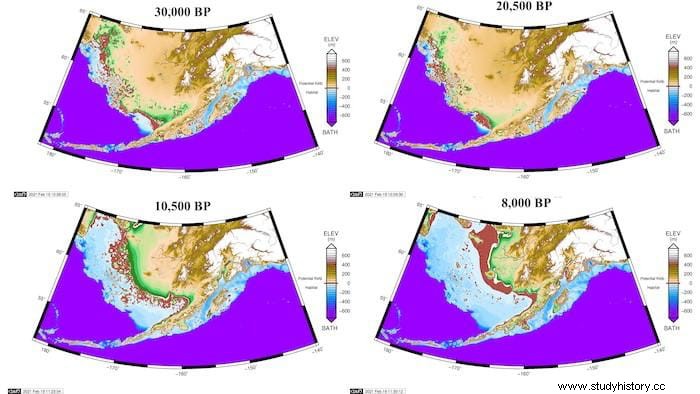For thousands of years, during the last ice age, generations of seafaring migrants rowed east across shallow ocean waters from Asia to present-day Alaska in leather boats. They traveled from island to island and eventually to the coast, surviving on the abundant seaweed, fish, shellfish, birds, and game gathered from the coastal and nearshore biomes. Its island-rich route was made possible by a shifting archipelago that stretched almost 900 miles from one continent to another.
A new study from the University of Kansas, in collaboration with the universities of Bologna and Urbino, documents the newly named Transitory Bering Archipelago and points out how, when and where the first Americans were able to cross. The authors' rung hypothesis hinges on the dozens of islands that arose during the last ice age as sea levels fell when ocean waters were locked up in glaciers and then rose when the ice sheets melted. The two-part study, which has just been published in the open access journal Comptes Rendus Geoscience , could answer what the writer Fen Montaigne calls one of the greatest mysteries of our time… when humans made the first daring voyage to the Americas .
The idea of steps is based on the retrospective mapping of sea level, taking into account isostasy, that is, the deformation of the earth's crust due to changes in the depth and weight of ice and water, which reached its maximum level during the Last Glacial Maximum, about 20,500 years ago.
We digitally discovered a sizable landform that had never been properly documented in the scientific literature said lead author Jerome Dobson. We call it the Bering Transitory Archipelago; it existed from about 30,000 years ago to 8,000 years ago. When we saw it, we immediately thought, 'Wow, maybe that's how the first Americans got here. And, in fact, everything we've tested seems to confirm it:it seems to be true.
For more than a decade, researchers have pondered a mystery within a mystery. Mitochondrial DNA indicates that the migrants were isolated somewhere up to 15,000 years ago on their way from Asia to North America. The Bering Stallion Hypothesis arises from the fact that today the DNA of Native Americans is very different from that of Asians, a clear indication of genetic drift of such magnitude that it can only have occurred over long periods of time in a almost total isolation of the population of Asian origin. The Transient Bering Archipelago provides adequate shelter with internal connectivity and insulation to the outside.
Dobson said the people crossing the Bering Sea probably didn't have sails, but they may have had experience paddling in skinned boats like the kayaks and umiaks that Inuit use today.
They probably traveled in small groups , he said, from Asia or from the islands off the coast of Asia . It is known that there were maritime people 27,000 years ago in the northern islands of Japan. They were probably maritime peoples, not only living on islands, but practicing culture, economics, and sea travel.
Recently, Dobson and co-authors Giorgio Spada, from the University of Bologna, and Gaia Galassi, from the Carlo Bo University of Urbino, applied an improved model of glacial isostatic adjustment to nine global choke points, that is, isthmuses and straits that have channeled transport and trade throughout history. Significant human migrations are known to have occurred through some of them, including Beringia , that is, all the portions of the Bering Sea that were exposed before, during, and after the Last Glacial Maximum.

At the end of that study, we suddenly saw these islands in the Bering Sea, and that became our goal. This had immediate potential because it could be a real game changer in terms of all the sciences understanding how migration worked in the past. We found surprising results at other chokepoints and have started looking at those as well .
In Beringia , the three researchers maintain, this action produced a "conveyor belt" of islands that rose from the sea and descended again, pushing gangs of people eastward. The first islands to appear were just off the coast of Siberia . Then islands appeared further and further to the east. Most likely, the emigrants continued to expand eastward as well, generally to islands within sight and within easy rowing distance .
10,500 years ago, when the Bering Strait itself appeared, almost all the western islands had been submerged. Only three islands remained, and the rowing distances had increased accordingly. Thus, the occupants were forced to evacuate, and faced a clear choice:return to Asia, which they knew was populated and might even have abandoned due to population pressure and scarce resources, or row east. , towards a lesser known territory, perhaps less populated islands with ample resources.
To fully confirm the idea put forward in the new paper, Dobson said researchers from many fields will have to collaborate as a geographer and two ocean scientists have done here.
We ourselves are in a phase where we definitely need an underwater confirmation , He said. This should encourage all relevant disciplines to question conventional theory and explore new ideas about how, when and where people came to North America .
